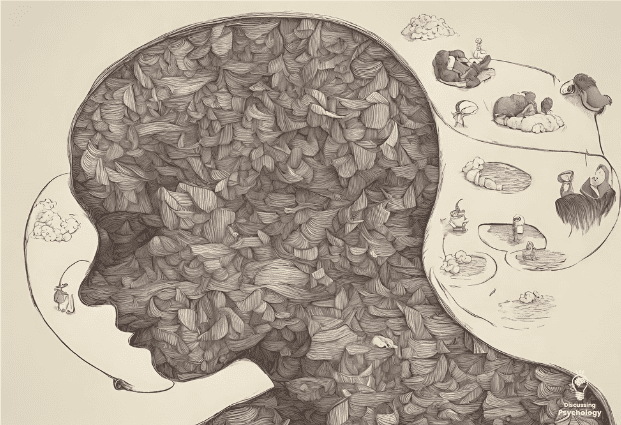Indulging in the occasional daydream here and there is perfectly normal and can even be considered a healthy behavior.
But where do we draw the line between regular daydreaming and maladaptive daydreaming?
How do you know if your daydreaming has become excessive, addictive and is causing impairment in the real-world?
Is it Maladaptive Daydreaming or Normal Daydreaming?
Essentially, distinguishing between normal daydreaming and maladaptive daydreaming boils down to three questions:
1. Do your daydreams bring you intense pleasure, to the point where you yearn to spend time daydreaming above all else?
2. Are your daydreams accompanied by repeated movements or other triggers to facilitate immersion?
3. Does your daydreaming cause you to experience worry and distress, or get in the way of other areas of your life?
If you answer ‘yes’ to all three questions above, then it’s likely that you could suffer from maladaptive daydreaming.
What if my Daydreaming Doesn’t Cause Distress?
Let’s say you answered yes to the first two questions above, but no to the third.
Maybe you enjoy spending your time in complex fantasy stories of your own devising, but you are able to keep a handle on the yearnings so that it doesn’t impact other areas of your life.
Like other mental health disorders, the criteria of distress and impairment are core parts of an MD diagnosis.
So if your daydreams don’t cause you any bother then you wouldn’t meet the criteria for maladaptive daydreaming no matter how much time you devote to them.
If this is you, you may be lucky enough to experience a condition known as Immersive Daydreaming (ID), which is essentially MD but without the negative aspects.
People capable of immersive daydreaming (and researchers do indeed think it’s a trait some of us possess and others do not) are able to enjoy all the fun of a complex inner life without having to suffer the consequences in their real lives.
When Does Daydreaming Become Maladaptive?
When does daydreaming become maladaptive? It turns out that there’s actually a psychological test that’s been developed to answer this exact question.
The Maladaptive Daydreaming Scale (MDS) is a questionnaire designed to identify symptoms of maladaptive daydreaming.
Developed in 2015 by researchers with hands-on experience working with maladaptive daydreamers, the 16 Point Maladaptive Daydreaming Scale has 16 questions which are designed to differentiate MD from normal daydreaming by assessing five separate characteristics:
We've created a free online test based on the 16 Point Scale for maladaptive daydreaming. Click here to take the MDS yourself.
1. Daydream Content
Maladaptive daydreamers engage in highly detailed, complex narratives akin to long-running TV shows, often putting themselves in positions of power and admiration.
Non-maladaptive daydreams are usually shorter and far less structured, often involving the mind wandering from topic to topic rather than specifically focusing on one story or idea.
2. Compulsion
People with MD experience a strong urge to daydream, often accompanied by compulsive or ritualized movement.
These movements act as triggers and serve to deepen immersion in the daydream. Neither the urge to daydream nor the physical movement aspect are present in normal daydreaming.
3. Distress
The uncontrollable and time-consuming nature of MD causes significant emotional distress, unlike normal daydreams, which are usually harmless.
4. Benefits
Despite the distress it causes, people with MD also report benefits to their daydreams in the form of intense pleasure and satisfaction.
While normal daydreams can be pleasant enough, they rarely bring about such a deep level of fulfillment.
5. Interference with Life Functioning
While normal daydreaming rarely has any impact on one’s larger life, MD can steal time and focus away from work, social relationships and other important areas of normal functioning.
Core Factors of Maladaptive Daydreaming
These five characteristics are a great starting point for differentiating normal from maladaptive daydreaming.
But if you want to go deeper, the researchers who developed the MDS found that by analyzing the responses from over 400 individuals with MD, they were able to boil down the components of maladaptive daydreaming into three core factors:
- Yearning: the intense pleasure created by MD, leading to a strong, sometimes uncontrollable, yearning or urge to daydream.
- Kinesthesia: the repetitive, compulsive movements such as pacing or hand movements, often accompanied by music or other media.
- Impairment: as described above, MD causes both emotional distress and practical impairment to one’s ability to live a functional life.
Taken together, these three factors can help you assess whether your daydreaming habits would be considered maladaptive.
As you may have noticed, the three questions at the start of this article used to determine if your daydreaming is maladaptive are based on these three core MD factors.
It’s Up to You
As a final caveat, it’s important to note that MD is not an officially recognized diagnosis, nor is the MDS a widely accepted measure.
You won’t find either in the Diagnostic and Statistical Manual or the International Classification of Diseases — the handbooks used to diagnose other mental health disorders.
This means that if you were to complete the MDS and take your results to a doctor or psychologist, it might not mean that much to them.
MD may well be included in later editions of the DSM or ICD, but until then, there’s really only one person who can diagnose your daydreaming as maladaptive, and that’s you.
If you think that your daydreams and fantasies are making your life worse, or if you think you’d be better off without them, that’s more than enough reason to seek out professional help and regain control of your waking hours.
- Somer, E., Lehrfeld, J., Bigelsen, J., & Jopp, D. (2016). Development and validation of the Maladaptive Daydreaming Scale (MDS). Consciousness and Cognition, 39, 77–91. https://doi.org/10.1016/j.concog.2015.12.001
- Stop maladaptive daydreaming. (n.d.) Maladaptive Daydreaming Test and over 600 past test results. https://maladaptivedaydreaming.org/pages/maladaptive-daydreaming-test
- Travers, M. (2021, September 7). What is maladaptive daydreaming? Therapytips. https://therapytips.org/interviews/what-is-maladaptive-daydreaming
- West, M., & Somer, E. (2019). Empathy, emotion regulation, and creativity in immersive and maladaptive daydreaming. Imagination, Cognition and Personality, 39(4), 358–373. https://doi.org/10.1177/0276236619864277

